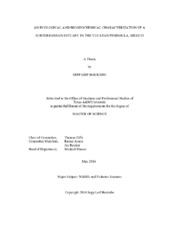| dc.contributor.advisor | Iliffe, Thomas M | |
| dc.creator | Haukebo, Sepp Leif | |
| dc.date.accessioned | 2015-01-09T19:56:58Z | |
| dc.date.available | 2015-01-09T19:56:58Z | |
| dc.date.created | 2014-05 | |
| dc.date.issued | 2014-01-16 | |
| dc.date.submitted | May 2014 | |
| dc.identifier.uri | https://hdl.handle.net/1969.1/152453 | |
| dc.description.abstract | Subterranean estuaries are biogeochemical reactors within the coastal aquifer and represent a processing zone of dissolved chemical constituents prior to submarine groundwater discharge (SGD). Highly stratified hydrologic layers and sharp physicochemical boundaries characterize anchialine caves, a subset of subterranean estuaries. This study serves as a biogeochemical and ecological characterization of Sistema Crustacea, an anchialine cave in the Yucatan Peninsula with dense populations of cave-adapted invertebrates.
Investigations of the physicochemical parameters found dissolved oxygen (DO) minimums and concurrent pH maximums as good indicators of localized microbial respiration within the shallow and deep haloclines. Beneath the deep halocline, a local DO and temperature maximum serve as evidence of counter current, tidal pumping of open seawater. Such evidence indicates that conventional circulation may not dominate groundwater flow along the Caribbean coast of Yucatan as some studies suggest.
Spatial variability of chromophoric dissolved organic matter (CDOM) was investigated using fluorescence spectroscopy and parallel factor analysis (PARAFAC). A terrestrial source dominated the CDOM signal within the freshwater layers. However, there was a clear shift in the brackish and marine layers to CDOM derived from microbial activity. The greatest concentration of DOC occurred in the freshwater pool with decreasing values in the deeper hydrologic layers. Evidence for non-conservative removal of dissolved organic carbon (DOC) and total nitrogen (TN) suggests that Sistema Crustacea acts as a sink for terrestrially derived organic matter destined to reach the coast. The anomalies detected in the physicochemical profiles suggest microbial respiration is partly responsible for this carbon and nitrogen removal as well as the shift in CDOM sources.
Swimming diver transects were used to characterize the invertebrate community throughout Sistema Crustacea and confirmed early observations that there are two ecologically distinct sections of the cave. The Eastern Section is characterized by high density of cave shrimp (Typhlatya pearsei), distributed in the brackish and marine layer, and remipedes (Xibalbanus tulumensis), observed solely in the marine layer. The Western Section shares the same entrance, but transects found a different species of remipede (Xibalbanus fuchscocksburni) and no T. pearsei. | en |
| dc.format.mimetype | application/pdf | |
| dc.language.iso | en | |
| dc.subject | subterranean estuary | en |
| dc.subject | anchialine cave | en |
| dc.subject | CDOM | en |
| dc.subject | chromophoric dissolved organic matter | en |
| dc.subject | PARAFAC | en |
| dc.subject | Yucatan Peninsula | en |
| dc.subject | Typhlatya pearsei | en |
| dc.subject | Xibalbanus tulumensis | en |
| dc.subject | Xibalbanus fuchscocksburni | en |
| dc.subject | | en |
| dc.title | An Ecological and Biogeochemical Characterization of a Subterranean Estuary in the Yucatan Peninsula, Mexico. | en |
| dc.type | Thesis | en |
| thesis.degree.department | Wildlife and Fisheries Sciences | en |
| thesis.degree.discipline | Wildlife and Fisheries Sciences | en |
| thesis.degree.grantor | Texas A & M University | en |
| thesis.degree.name | Master of Science | en |
| thesis.degree.level | Masters | en |
| dc.contributor.committeeMember | Rooker, Jay R | |
| dc.contributor.committeeMember | Amon, Rainer MW | |
| dc.type.material | text | en |
| dc.date.updated | 2015-01-09T19:56:58Z | |


